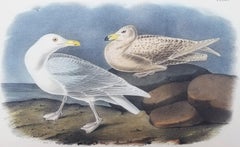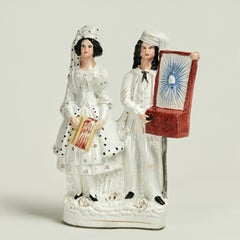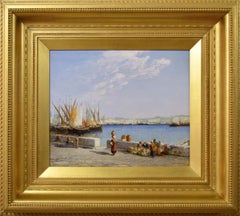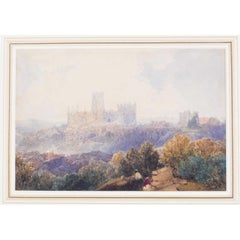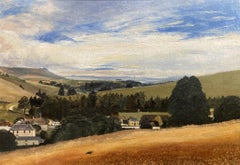Victorian Art
to
226
888
397
349
212
179
Overall Width
to
Overall Height
to
33
1,338
635
19
46
19
12
1
2
1
10
8
1
32
114,527
65,077
54,942
27,050
14,929
9,364
6,540
5,776
4,190
3,060
2,585
2,326
2,252
719
1,210
764
21
961
306
271
250
243
207
159
151
147
133
130
130
128
126
125
95
91
86
83
79
1,567
1,239
485
479
331
51
27
26
22
16
1,140
52
1,295
417
Style: Victorian
Glaucus Gull - Burgomaster /// Ornithology Bird John James Audubon Seascape Sky
Located in Saint Augustine, FL
Artist: John James Audubon (American, 1785-1851)
Title: "Glaucus Gull - Burgomaster" (Plate 449, No. 90)
Portfolio: The Birds of America, First Royal Octavo Edition...
Category
1840s Victorian Art
Materials
Watercolor, Lithograph
Antique Staffordshire Double Musical Figures
Located in Palm Beach, FL
Unusual 19th century English Staffordshire musical figures crafted in porcelain and hand decorated depicting a female figure with an accordion and a male with a barrel piano.
Category
19th Century Victorian Art
Materials
Porcelain
19th Century Italian townscape coastal oil painting of Livorno, Gulf of Genoa
Located in Nr Broadway, Worcestershire
Arthur Joseph Meadows
British, (1843-1907)
Livorno, Gulf of Genoa
Oil on panel, signed & dated (18)98, with signed & inscribed label on reverse
Image size: 9.75 inches x 11.75 inches
Size including frame: 17.75 inches x 19.75 inches
An attractive townscape depicting fruit sellers at the port of Livorno, Italy by Arthur Joseph Meadows. The scene shows the view looking across from the harbour wall to the church of Santa Caterina...
Category
19th Century Victorian Art
Materials
Oil, Panel
The President of St John's College Oxford Vanity Fair Spy magazine Leslie Ward
Located in London, GB
To see our other views of Oxford and Cambridge, particularly suitable for wedding and graduation presents, scroll down to "More from this Seller" and below it click on "See all from ...
Category
1890s Victorian Art
Materials
Lithograph
William Roxby Beverley 'Durham Cathedral from the North East' University
Located in London, GB
To see our other views and maps of England - including London, Durham, Oxford and Cambridge, scroll down to "More from this Seller" and below it click on "See all from this Seller" -...
Category
19th Century Victorian Art
Materials
Watercolor
Island of Gibraltar, Oil 19th Century Landscape
Located in London, GB
Oil on canvas
Image size: 8 3/4 x 12 1/2 inches (22 1/4 x 31 3/4 cm)
Gilt frame
This is a painting from the 19th Century depicts Gibraltar Island in Ohio, America, located within la...
Category
19th Century Victorian Art
Materials
Canvas, Oil
19th Century Oil Painting of a Market Scene by H. C. Bryant
By Henry Charles Bryant
Located in London, GB
19th century oil painting of a market scene by H. C. Bryant
English, 1877
Canvas: Height 51cm, width 76.5cm
Frame: Height 68cm, width 93.5cm, depth 5cm
Painted by the English artist Henry Charles Bryant, this lively scene is typical of Bryant’s oeuvre. Bryant specialised in market and farmyard scenes, inspired by 17th century Dutch genre painting which similarly depicted vignettes of everyday life. Bryant’s realistic painterly style also recalls these Dutch genre scenes, which in turn were inspired by the form and content of Early Netherlandish...
Category
Late 19th Century Victorian Art
Materials
Canvas, Oil
John Fulleylove Trinity College Great Court, Cambridge 1890 watercolour
Located in London, GB
To see our other views of Oxford and Cambridge, scroll down to "More from this Seller" and below it click on "See all from this Seller" - or send us a message if you cannot find the ...
Category
Late 19th Century Victorian Art
Materials
Watercolor
The Doorway, Baalbec
Located in London, GB
David Roberts RA
The Doorway, Baalbec
1796 - 1864
Subscription and first edition lithograph available
Full plate 81
Presented in a acid free mount
Hand coloured lithograph printed i...
Category
19th Century Victorian Art
Materials
Lithograph
Pair of 19th Century sporting oil paintings of terrier dogs
Located in Nr Broadway, Worcestershire
**PLEASE NOTE: EACH PAINTING INCLUDING THE FRAME MEASURES 22.25 INCHES x 18.25 INCHES**
Edward Armfield
British, (1857-1935)
The Rat Trap & Under the Wheelbarrow
Oil on canvas, pair...
Category
19th Century Victorian Art
Materials
Canvas, Oil
Christmas Winter English watercolor of a Caffinch on a snow covered tree
By Ella Bruce
Located in Woodbury, CT
An outstanding painting by author and painter Ella Bruce. This watercolor is of the finest quality and shows the skill of the painter to the full. A vibrant and unique piece. The white highlights are painted in gouache or body color, which gives the piece great depth and an added level of quality.
This and the others from the collection were I'm sure painted for Christmas or Holiday cards...
Category
1970s Victorian Art
Materials
Watercolor
Victorian Ladies, by female artist Letitia Bonnet Hart
By Letitia Bonnet Hart
Located in Philadelphia, PA
Letitia Bonnet Hart
(American, 1867-1953)
Victorian Ladies
Oil on canvas, 21 x 16 1/4 inches
FRAMED: 28 x 23 inches (approx.)
Signed at lower right: "Letitia B. Hart"
Label on stretcher: "Marbella Gallery, New York"
Daughter of the Hudson River School painter James McDougal Hart, Letitia was born into an extended family of accomplished artists. After preliminary study with her father and mother, she attended the Brooklyn Academy of Design and the National Academy of Design. She began exhibiting at the age of eighteen, and continued to exhibit in Brooklyn, Philadelphia, Massachusetts, Louisiana Purchase Exhibition, and the 1893 World’s Columbian Exposition...
Category
Late 19th Century Victorian Art
Materials
Canvas, Oil
19th Century landscape animal oil painting of cattle & sheep by a river
Located in Nr Broadway, Worcestershire
Thomas Sidney Cooper
British, (1803-1902)
Canterbury Meadows
Oil on canvas, signed & dated ‘T. Sidney Cooper RA/1894
Image size: 14.75 inches x 24.75 i...
Category
19th Century Victorian Art
Materials
Canvas, Oil
Bahamian Street Scene Watercolor Painting
Located in Palm Beach, FL
Watercolor painting on paper of a Bahamian street scene possibly in Nassau. Complete with a woman carrying a bundle, a man in a cart, palm trees, house, gates and warm peaceful ambia...
Category
Early 20th Century Victorian Art
Materials
Watercolor, Paper
Pair of 19th Century military oil paintings of volunteer rifle soldiers
Located in Nr Broadway, Worcestershire
**PLEASE NOTE: EACH PAINTING INCLUDING THE FRAME MEASURES 26.25 INCHES X 37.25 INCHES**
Frederick Henry Howard Harris
British, (1829-1901)
Volunteer Rifl...
Category
19th Century Victorian Art
Materials
Canvas, Oil
19th Century Portrait of Jerry and Dot a Pair Two Naughty Friends
By Imogen Mary Collier
Located in London, GB
Imogen Mary Collier (1873-1952)
Portrait of Jerry and Dot
Circa. 1895-1900
Oil on Canvas
49 X 42.5
Imogen Mary Collier (1873-1952) was born in 1873 at Whitchurch, Devon, England. She was the daughter of Mortimer John Collier...
Category
1890s Victorian Art
Materials
Oil
The Acropolis, Lower End of the Valley
Located in London, GB
David Roberts RA
The Acropolis, Lower End of the Valley
1796 - 1864
Subscription and first edition lithographs in stock
Full plate: 102
Presented in a acid free mount
Category
19th Century Victorian Art
Materials
Lithograph
Pair of Antique Tropical Watercolor Paintings
Located in Palm Beach, FL
Rare pair of 19th Century watercolors on paper painted in tropical settings both signed MWW 87 and presented in wood frames under glass.
Category
Late 19th Century Victorian Art
Materials
Watercolor
Historical genre sporting oil painting of a gentleman hunter
Located in Nr Broadway, Worcestershire
Adolphe Alexandre Lesrel
French, (1839-1929)
The Sportsman
Oil on panel, signed & dated 1903
Image size: 9.75 inches x 7 inches
Size includin...
Category
19th Century Victorian Art
Materials
Oil, Panel
Watercolour study of a resting infant, possibly the artist's daughter
Located in Henley-on-Thames, England
William Henry Hunt OWS (1790-1864) (attrib.)
Study of a resting infant
Watercolour and graphite heightened with zinc oxide on paper
13.9 x 18.5 cm.; (within frame) 31.1 x 25.6 cm.
Un...
Category
Mid-19th Century Victorian Art
Materials
Watercolor
19th century landscape oil painting of figures at Sutton Park
Located in Nr Broadway, Worcestershire
William E Harris
British, (1854-1930)
*Sutton Park
Oil on canvas, signed & dated 1884, inscribed verso
Image size: 9.5 inches x 15.5 inches
Size incl...
Category
19th Century Victorian Art
Materials
Canvas, Oil
19th Century landscape oil painting of a bridge over a river
Located in Nr Broadway, Worcestershire
Sir David Murray
Scottish, (1849-1933)
The Bridge
Oil on canvas, signed & further inscribed verso
Image size: 17.75 inches x 23.75 inches
Size including frame: 26.25 inches x 32.25 ...
Category
19th Century Victorian Art
Materials
Canvas, Oil
19th Century French bronze sculpture of monkeys racing on horses
By Paul Joseph Raymond Gayrard
Located in Nr Broadway, Worcestershire
Paul Joseph Gayrard
French, (1807-1855)
Six Tours
Bronze, signed, also signed with foundry signature & mark for Boyer
Height: 9 inches
Width: 9 inches
Depth: 6.5 inches
Paul Josep...
Category
19th Century Victorian Art
Materials
Bronze
Oil Painting 'The Strid, near Bolton Abbey Wharfedale' by Walter Williams
Located in Mere, GB
Oil Painting 'The Strid, near Bolton Abbey Wharfedale' by Walter Williams. Walter Williams 1835-1906 was a painter of the highly popular Williams family o...
Category
19th Century Victorian Art
Materials
Oil
$5,454 Sale Price
24% Off
20th century lithograph realism figurative female print female subject signed
Located in Milwaukee, WI
"Woman Manicuring Her Nails" is an original lithograph by Maximilien Luce. The artist signed the piece lower right and it is numbered (#7). It features a woman seated in an interior taking care of her nails.
8 1/4" x 5 3/4" image
14 1/8" x 10 3/4" paper
19 1/4" x 16 1/2" frame
Maximilien Luce (1858 – 1941) was a prolific French Neo-impressionist artist, known for his paintings, illustrations, engravings, and graphic art, and also for his anarchist activism. Starting as an engraver, he then concentrated on painting, first as an Impressionist, then as a Pointillist, and finally returning to Impressionism.
Gausson and Cavallo-Péduzzi introduced Luce in about 1884 to the Divisionist technique developed by Georges Seurat. This influenced Luce to begin painting in the Pointillist style. In contrast to Seurat's detached manner, Luce's paintings were passionate portrayals of contemporary subjects, depicting the "violent effects of light". In addition to Pissarro and Signac, he met many of the other Neo-impressionists, including Seurat, Henri-Edmond Cross, Charles Angrand, Armand Guillaumin, Hippolyte Petitjean, Albert Dubois...
Category
Early 1900s Victorian Art
Materials
Lithograph
Bird's Nest, Victorian 19th Century Royal Academy Oil
Located in London, GB
William Henry Hunt
1790 - 1864
Bird's Nest
Oil on canvas
Image size: 11½ x 8⅜ inches
William Henry Hunt was a painter and watercolourist of fruit and flowers, landscapes and rust...
Category
19th Century Victorian Art
Materials
Canvas, Oil
'Birchbark Sap Buckets and Yoke' original halftone print, Bureau of Ethnology
Located in Milwaukee, WI
This halftone print was included in the 1898 report of the Bureau of Ethnology to the Smithsonain Institution. The sap buckets and yoke are from the Menomin...
Category
1890s Victorian Art
Materials
Lithograph
19th century ink drawing seated female figure with book sketch signed
By Hannah de Rothschild
Located in Milwaukee, WI
"The New Year" is a pen and ink on paper portrait signed by Hannah de Rothschild. A girl sits quietly in a corner with a cap. Her focus is on a book in her lap, she is about to rip a...
Category
1860s Victorian Art
Materials
Paper, Ink, Pen
Principal Court of the Convent of St. Catherine
Located in London, GB
First Edition lithograph
Full plate: 120
Presented in a acid free mount
Category
19th Century Victorian Art
Materials
Lithograph
"Birthplace of Henry Clay, Hanover County, VA, " Lithograph by Kelloggs & Thayer
Located in Milwaukee, WI
"Birthplace of Henry Clay, Hanover County, Virginia" is an original hand-colored lithograph by Kelloggs & Thayer. The piece features a homestead and farm anima...
Category
1870s Victorian Art
Materials
Lithograph
Remains of the Triumphal Arch, Petra
Located in London, GB
David Roberts RA
Remains of the Triumphal Arch, Petra
1796 - 1864
Subscription and First Edition lithographs
Full plate: 100
Presented in a acid free mount
Category
19th Century Victorian Art
Materials
Lithograph
Antique Danish Orientalist Oil Painting of a Military Scene by Niels Simonsen
Located in London, GB
Antique Danish Orientalist oil painting of a military scene by Niels Simonsen
Danish, 1860
Canvas: Height 27cm, width 35cm
Frame: Height 43cm, width 52cm, depth 4cm
This very fine O...
Category
1860s Victorian Art
Materials
Oil, Canvas
Ancient Watch Tower
Located in London, GB
David Roberts RA
Ancient Watch Tower
1796 - 1864
Subscription and first edition lithograph in stock
Half plate: 93
Presented in a acid free mount
Category
19th Century Victorian Art
Materials
Lithograph
Gaillard, Lecomte, and Cie - Parisian Fashion Trade Hand Painted Catalogue Print
Located in Jacksonville, FL
Transport yourself to the elegance of Victorian French fashion with this vintage lithograph print featuring exquisite ladies' La Mode dresses. The unframed size of the print measures...
Category
Early 20th Century Victorian Art
Materials
Paper
$4,400 Sale Price
20% Off
19th Century seascape oil painting of a hay barge on the Medway
Located in Nr Broadway, Worcestershire
Hubert Thornley
British, (exh. 1858 -1898)
Hay Barge on the Medway
Oil on canvas, signed
Image size: 23.5 inches x 17.5 inches
Size including frame: 30.5 inches x 24.5 inches
A fine...
Category
19th Century Victorian Art
Materials
Canvas, Oil
"Windmills by a Dutch Waterway" by Joseph Paul
Located in Mere, GB
"Windmills by a Dutch Waterway" by Joseph Paul. Joseph Paul was a Norwich landscape painter in the Dutch tradition. Regular local Exhibitor. Oil on canvas.
Dimensions unframed
heig...
Category
19th Century Victorian Art
Materials
Oil
$4,431 Sale Price
34% Off
Lower Portion of El Khasne, Petra
Located in London, GB
Subscription and first edition lithograph in stock
Full plate: 94
Presented in a acid free mount
Category
19th Century Victorian Art
Materials
Lithograph
19th Century Botanical Engraving of Chirita Walkeria. Hand-Colored Print by Gar
Located in Jacksonville, FL
A captivating 19th-century botanical engraving depicting Chirita walkeria, a delicate flowering plant named in honor of Anna Maria Walker, a noted naturalist. This hand-colored print...
Category
Early 19th Century Victorian Art
Materials
Engraving
"A Siamese Water Market" by Edwin Norbury
Located in Mere, GB
"A Siamese Water Market" by Edwin Norbury. Edwin Arthur Norbury. R.C.A 1849- 1918 was a founder member of the royal Cambrian academy visited Siam in 1892 to...
Category
19th Century Victorian Art
Materials
Oil
$2,999 Sale Price
21% Off
Wool Work 'Woolie' Needlepoint Embroidery of the British Ship Amelia
Located in Palm Beach, FL
Large antique needlepoint of the British sailing ship Amelia hand crafted in wool, popularly known as woolies, crafted with ambitious detail. Pres...
Category
Late 19th Century Victorian Art
Materials
Wool
"Winter Landscape with Sheep and Shepherd", original water colour on paper
Located in Naples, Florida
This is an original unique watercolour by the artist. Florence Emily Lumb lived and exhibited her work between 1897 – 1901 in Liverpool at the Walker Art Gallery.
Category
20th Century Victorian Art
Materials
Watercolor
Convent of St. Catherine, Mt. Horeb
Located in London, GB
First edition lithographs in stock
Full plate: 118
Presented in a acid free mount
Category
19th Century Victorian Art
Materials
Lithograph
Whirling Dervish
Located in Nr Broadway, Worcestershire
Franz Xavier Bergman
Austrian, (1861-1936)
Whirling Dervish
Bronze, cold painted, signed 'B' in a vase
Height: 6¾ inches
Width: 2 inches
Depth: 2 inch...
Category
19th Century Victorian Art
Materials
Bronze
19th Century landscape oil painting of figures picking flowers at a river bank
Located in Nr Broadway, Worcestershire
Robert John Hammond
British, (1853-1911)
Picking Flowers
Oil on canvas, signed & dated 1900
Image size: 20.75 inches x 13.75 inches
Size including frame: 30.5 inches x 23.5 inches
A charming landscape painting of figures picking flowers next to a river by Robert John Hammond. The scene is set against the backdrop of mountains and was most likely painted in summer. The landscape appears similar to that of North Wales, an area the artist visited a number of times.
Robert John Hammond was a landscape painter born in Blackfriars, London in 1853. By the time he was 18 he had moved to Sutton Coldfield where he initially became an apprentice watchmaker before becoming a full time artist. In 1871, he married Lucy Banner, the sister of the artist Alfred Banner...
Category
19th Century Victorian Art
Materials
Canvas, Oil
"Near Tamerton Devon" by William Pitt
Located in Mere, GB
"Near Tamerton Devon" by William Pitt. William Pitt 1818-1900 was a fine midlands landscape painter of local scenes and south west views. A regular exhibitor at London and Birmingham...
Category
19th Century Victorian Art
Materials
Oil
$6,136 Sale Price
23% Off
Animal oil painting of a woman feeding calves & chickens
Located in Nr Broadway, Worcestershire
Claude Cardon
British, (1864-1937)
Feeding Time in the Orchard
Oil on canvas, signed & dated 1918
Image size: 19.25 inches x 29.25 inches
Size including frame: 27.5 inches x 37.5 in...
Category
Early 20th Century Victorian Art
Materials
Canvas, Oil
The Pool of Bethesda- Jerusalem
Located in London, GB
THE POOL OF BETHESDA- JERUSALEM
Subscription and first edition lithographs in stock
Full plate: 12
Presented in a acid free mount
£1,200
Published by F.G. Moon & Son, London 1842-49.
Subscription edition were coloured during production and First edition are modern hand-coloured lithograph, that was printed a few years after the subscription edition David Roberts.
We have both Subscription and First Edition lithographs in stock. The subscription edition was printed on a fine paper, hand coloured and then stuck on card. The first edition was printed on a more coarse paper and not coloured by hand. These ones we colour to match the subscription colouring. Each lithograph is sold in mint condition and in an acid free mount.
Please do not hesitate to contact us for more information, or if you are looking for another David Roberts lithograph...
Category
19th Century Victorian Art
Materials
Lithograph
Historical genre sporting oil painting of a gentleman holding a gun
Located in Nr Broadway, Worcestershire
Adolphe-Alexandre Lesrel
French, (1839-1929)
The Sportsman
Oil on panel, signed & dated 1905
Image size: 10.75 inches x 7.75 inches
Size including frame: 19.5 inches x 16.5 inches
A beautifully detailed genre painting of a gentleman with a hunting rifle and smoking a clay pipe by Adolphe Alexandre Lesrel. The man, who is dressed in 17th century costume is seated next to a table containing game, a wine decanter and silver gilt standing cup with cover. All of the props including the 17th century wheel lock...
Category
19th Century Victorian Art
Materials
Oil, Panel
The Theatre, Petra
Located in London, GB
First Edition lithograph
Full plate: 98
Presented in a acid free mount
Category
19th Century Victorian Art
Materials
Lithograph
Glaucium Phoenicium (Red Horned-Poppy) /// James Sowerby Botanical Flower Plant
Located in Saint Augustine, FL
Artist: James Sowerby (English, 1757-1822)
Title: "Glaucium Phoenicium (Red Horned-Poppy)" (Vol. 7, Plate 1433)
Portfolio: English Botany; or, Coloured Figures of British Plants
Year...
Category
Early 1800s Victorian Art
Materials
Watercolor, Engraving, Intaglio
Set of Three Hand-Colored Lithographs from Roscoe's "Monandrian Plants"
Located in Saint Augustine, FL
Artist: William Roscoe (English, 1753-1831)
Title: "Phrynium Myrosma", "Costus Maculatus", and "Kaempferia Galanga (Aromatic Ginger)"
Portfolio: Monandrian Plants of the order Scitam...
Category
1820s Victorian Art
Materials
Watercolor, Lithograph
Set of Two Hand-Colored Lithographs from Roscoe's "Monandrian Plants" /// Botany
Located in Saint Augustine, FL
Artist: William Roscoe (English, 1753-1831)
Titles: "Hedychium Glaucum" and "Zingiber Elatum"
Portfolio: Monandrian Plants of the order Scitamineae, Chiefly Drawn from Living Specime...
Category
1820s Victorian Art
Materials
Watercolor, Lithograph
19th Century genre oil painting of a young woman knitting beside a girl
Located in Nr Broadway, Worcestershire
John William Haynes
British, (1831-1924)
Knitting
Oil on canvas, signed
Image size: 29.5 inches x 24.5 inches
Size including frame: 35 inches x 3...
Category
19th Century Victorian Art
Materials
Canvas, Oil
KPM Porcelain Plaque - Proper Woman with Carved Gilt Wood Frame
Located in Jacksonville, FL
Frame Size: Hight: 15.50″ x Width: 12.50″
Frame Thickness: 3″
Picture Size: Hight: 9.25″ x Width: 6.25″
Immerse yourself in the presence of a distinguished gentleman with this exceptional Antique KPM Porcelain Plaque...
Category
19th Century Victorian Art
Materials
Porcelain
19th Century landscape oil painting of figures with a donkey & cart
Located in Nr Broadway, Worcestershire
Arthur Walker Redgate
British, (1860-1906)
A Wayside Chat
Oil on canvas, signed
Image size: 13.5 inches x 20.5 inches
Size including frame: 19.5...
Category
19th Century Victorian Art
Materials
Canvas, Oil
19th Century genre oil painting of man preparing fishing tackle
Located in Nr Broadway, Worcestershire
John Arthur Lomax
British, (1857-1923)
Preparing his Tackle
Oil on panel, signed
Image size: 11.75 inches x 9.75 inches
Size including frame: 21 inches x 19 inches
A fabulous genr...
Category
19th Century Victorian Art
Materials
Oil, Panel
General View of the Island of Philae, Nubia
Located in London, GB
General View of the Island of Philae, Nubia
Subscription and first edition lithographs in stock
Full plate: 151
Presented in a acid free mount
£2080
Scroll down for more information....
Category
19th Century Victorian Art
Materials
Lithograph
19th Century genre portrait of an Italian woman
By Pierre-Louis-Joseph de Coninck
Located in Nr Broadway, Worcestershire
Pierre Louis Joseph De Coninck
French, (1828-1910)
Italian Beauty
Oil on canvas, signed
Image size: 31 inches x 23 inches
Size including frame: 38 inches x 30 inches
A lovely three...
Category
19th Century Victorian Art
Materials
Canvas, Oil
English Caricature Watercolour Painting, Victorian, 1902
Located in Hoddesdon, GB
An English Caricature Watercolour painting signed with the artists monogram & dated 1902 .
A beautiful painting of a tamp playing a trumpet on a winters day , outside a house that is for sale or to let .
( It makes me wonder if the tramp portrayed in the painting was once the owner of the property but has fallen on hard times...
Category
Early 1900s Victorian Art
Materials
Watercolor
Shipping in the River Humber Off Hull, England
Located in Costa Mesa, CA
This original watercolor on paper features traffic on the River Humber in the City of Hull. Hull or Kingston upon Hull, is a port city in East Yorkshire, England. The painting is hig...
Category
1870s Victorian Art
Materials
Paper, Watercolor
Victorian art for sale on 1stDibs.
Find a wide variety of authentic Victorian art available for sale on 1stDibs. Works in this style were very popular during the 21st Century and Contemporary, but contemporary artists have continued to produce works inspired by this movement. If you’re looking to add art created in this style to introduce contrast in an otherwise neutral space in your home, the works available on 1stDibs include elements of blue, orange, purple, yellow and other colors. Many Pop art paintings were created by popular artists on 1stDibs, including Francis E. Jamieson, Sir Leslie Ward, John James Audubon, and George Cruikshank. Frequently made by artists working with Paint, and Oil Paint and other materials, all of these pieces for sale are unique and have attracted attention over the years. Not every interior allows for large Victorian art, so small editions measuring 1.5 inches across are also available. Prices for art made by famous or emerging artists can differ depending on medium, time period and other attributes. On 1stDibs, the price for these items starts at $49 and tops out at $153,923, while the average work sells for $2,035.
Still Thinking About These?
All Recently ViewedMore Ways To Browse
Mauritz Lindstrom
Maximillien Luce
Michael Budden Central Park
Midcentury Matador Paintings
Mike Wright
Miracle On Ice
Mississippi River Painting
Monarch Of The Glen Painting
Moroccan Paintings Essaouira
Morpho Butterfly Art
Mount Tamalpais
Murray Dessner
Native American Oklahoma
New England Barn
New Orleans Jazz Poster
Niagara Falls Oil
Oil Painting By Alice
Oil Painting Willow Tree
